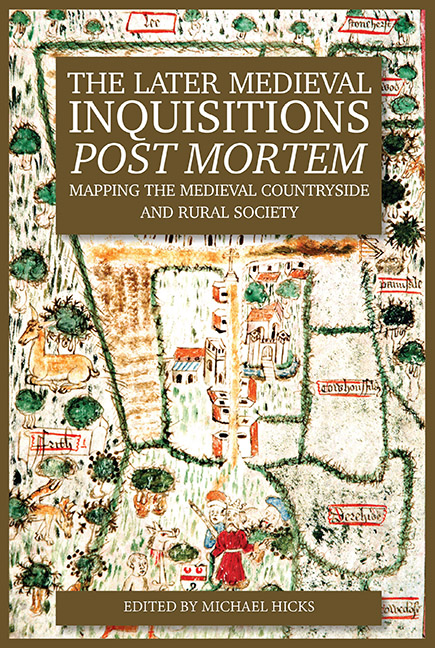Book contents
- Frontmatter
- Contents
- List of Illustrations
- List of Contributors
- Glossary
- List of Abbreviations
- 1 Introduction
- 2 Records of an Imperial Administration? Inquisitions Post Mortem in Scotland and Calais
- 3 Inquisitions Post Mortem in Medieval Ireland
- 4 The Court of the Honour of Clare, 1308–60: Feudal Incidents and Inquisitions
- 5 Landscape, Farming and Society in an English Region: The Inquisitions Post Mortem for the West Midlands, 1250–1509
- 6 Beyond the Dots: Mapping Meaning in the Later Medieval Landscape
- 7 Fairs and Markets in the Inquisitions Post Mortem
- 8 The Structure of the Milling Industry 1427–37
- 9 Proofs of Age 1246 to 1430: Their Nature, Veracity and Use as Sources
- 10 What Went On in the Medieval Parish Church, 1377–1447, with Particular Reference to Churching
- 11 Retainers, Monks and Wine: Three Insights into Everyday Life
- 12 The Administration and Efficiency of the Inquisitions Post Mortem Process: A Case Study of Northumberland
- 13 Late Medieval Land Disputes and the Manipulation of the Inquisitions Post Mortem
- Index
10 - What Went On in the Medieval Parish Church, 1377–1447, with Particular Reference to Churching
Published online by Cambridge University Press: 26 May 2021
- Frontmatter
- Contents
- List of Illustrations
- List of Contributors
- Glossary
- List of Abbreviations
- 1 Introduction
- 2 Records of an Imperial Administration? Inquisitions Post Mortem in Scotland and Calais
- 3 Inquisitions Post Mortem in Medieval Ireland
- 4 The Court of the Honour of Clare, 1308–60: Feudal Incidents and Inquisitions
- 5 Landscape, Farming and Society in an English Region: The Inquisitions Post Mortem for the West Midlands, 1250–1509
- 6 Beyond the Dots: Mapping Meaning in the Later Medieval Landscape
- 7 Fairs and Markets in the Inquisitions Post Mortem
- 8 The Structure of the Milling Industry 1427–37
- 9 Proofs of Age 1246 to 1430: Their Nature, Veracity and Use as Sources
- 10 What Went On in the Medieval Parish Church, 1377–1447, with Particular Reference to Churching
- 11 Retainers, Monks and Wine: Three Insights into Everyday Life
- 12 The Administration and Efficiency of the Inquisitions Post Mortem Process: A Case Study of Northumberland
- 13 Late Medieval Land Disputes and the Manipulation of the Inquisitions Post Mortem
- Index
Summary
The jurors at proofs of age were never eye-witnesses to the birth itself, for men were barred from the birthing chamber. Midwives and other females at the birth never testified. Instead, several of the proofs detail, as mnemonics (reminders), the journey to tell the father of the birth. John Speman recollected being sent, on 1 August 1385, to London from Datchet, Buckinghamshire to alert John Arundel's father to the birth. Will Dickon, on 17 September 1381, was present when the father was informed. What the jurors recalled was the ceremony of baptism, often witnessed whilst attending mass or some other service. Proofs of age therefore focused not on the birth of the heir, but on the baptism, a formal religious rite that was generally conducted on the same day or the very next day. Medieval babies were baptised at once, so that if they died they were nevertheless eligible for salvation. It was the christening that made them Christian. Proofs of age record only the live births of future heirs that survived. There are many cases like Hugh Willoughby, baptised at Risley (Derb.) in 1413, who was not the eldest son at birth, but who succeeded to the family inheritance after the deaths of his elder brother and his father. It was permitted for weak children to be christened privately, by lay people, even by midwives, but none is recorded in the proofs, presumably because any heirs so baptised did indeed die. The vast majority of baptisms happened in parish churches, a very few in monasteries or private chapels. Proofs of age give us a snapshot of what was going on in a particular parish church at a particular point in the church calendar.
The baptism service involved both sexes, but it was also differentiated by gender in ways that stressed female inferiority. Only a girl child was exorcised at baptism. The proofs of age are the principal source for churching, the service of purification of the mother following each pregnancy that presumably occurred millions of times in the later Middle Ages, thousands of times in every parish church. Churching was a ceremony that has been rather neglected: it alone placed women at the centre of religious practice.
- Type
- Chapter
- Information
- The Later Medieval Inquisitions Post MortemMapping the Medieval Countryside and Rural Society, pp. 161 - 173Publisher: Boydell & BrewerPrint publication year: 2016



